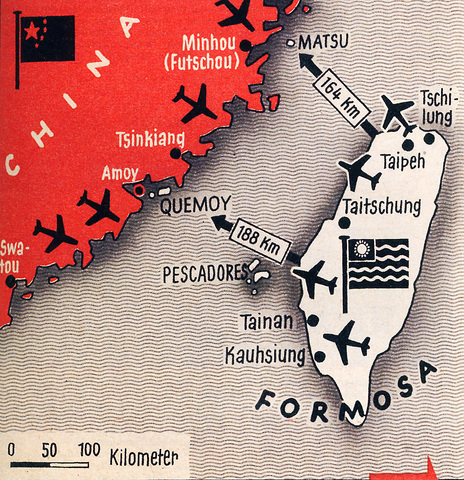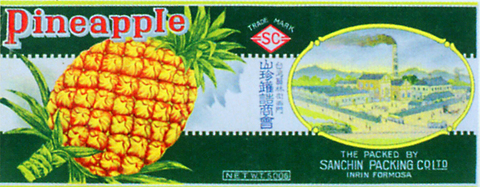People in Taiwan seem to have a fascination with maps, which is odd considering that a vast majority of those published in Taiwan, be they tourist or transport maps, are incorrect and impossible to comprehend.
The population might be cartographically challenged, but this doesn't stop books focusing on old maps of Taiwan from becoming bestsellers, copies of the Council for Cultural Affairs' (CCA,
And the current Taiwan in Maps (

PHOTOS COURTESY OF NATIONAL TAIWAN MUSEUMN
Taiwan in Maps is one of the largest exhibitions to be hosted by the museum in recent years, and the extensive and fascinating displays are located in exhibition halls on all three floors of the museum.
Jointly organized by the CCA and the museum, the exhibition features dozens of original maps and an equal number of reproductions and copies, along with photographs and other artifacts related to cartography in Taiwan.
While those with a whim for cartography and/or Taiwan history will have already seen some of the better-known maps on display and in various publications, there are still plenty of maps in the exhibition that will stoke the interests of anyone with an eye for geography or history.

The exhibition is well-organized and covers every conceivable topic and theme, from the earliest maps of Taiwan hand drawn by Portuguese and Spanish explorers in the 15th century to explanations of cutting-edge satellite imagery used by cartographers now.
Along with the multitude of geographic and topographic maps, there are also plenty of demographic maps on display. These include maps that plot Taiwan's indigenous peoples, the nation's economic growth, Taiwan's farming production and its transportation networks.
Although the maps are far too numerous to give a detailed account of all those on display, a couple of the most eye-catching charts include a simplified military map from 1958 showing the possible flight paths of military aircraft in the event of war with China, and a highly detailed map of Taiwan drawn by members of the Royal Geographic Society in 1864.
Taiwan in Maps is comprehensive and gives visitors insight into the history of cartography in Taiwan, but it is not without its flaws. As is all too often the case with exhibitions in Taiwan, be they at national or regional level, the lack of English-language information is big disappointment. Considering President Chen Shui-bian (
language material is in this instance best described as deplorable.
In addition to the exhibition, the museum has also published a comprehensive guidebook, which features a myriad of glossy photographs and explanations of many of the maps on display. Like the explanations that accompany the exhibits, the Taiwan in Maps guidebook is only available in Chinese.
Event Information:
What: Taiwan in Maps (
Where: National Taiwan Museum (
When: Through Sept. 18

Last week, the the National Immigration Agency (NIA) told the legislature that more than 10,000 naturalized Taiwanese citizens from the People’s Republic of China (PRC) risked having their citizenship revoked if they failed to provide proof that they had renounced their Chinese household registration within the next three months. Renunciation is required under the Act Governing Relations Between the People of the Taiwan Area and the Mainland Area (臺灣地區與大陸地區人民關係條例), as amended in 2004, though it was only a legal requirement after 2000. Prior to that, it had been only an administrative requirement since the Nationality Act (國籍法) was established in

Three big changes have transformed the landscape of Taiwan’s local patronage factions: Increasing Democratic Progressive Party (DPP) involvement, rising new factions and the Chinese Nationalist Party’s (KMT) significantly weakened control. GREEN FACTIONS It is said that “south of the Zhuoshui River (濁水溪), there is no blue-green divide,” meaning that from Yunlin County south there is no difference between KMT and DPP politicians. This is not always true, but there is more than a grain of truth to it. Traditionally, DPP factions are viewed as national entities, with their primary function to secure plum positions in the party and government. This is not unusual

The other day, a friend decided to playfully name our individual roles within the group: planner, emotional support, and so on. I was the fault-finder — or, as she put it, “the grumpy teenager” — who points out problems, but doesn’t suggest alternatives. She was only kidding around, but she struck at an insecurity I have: that I’m unacceptably, intolerably negative. My first instinct is to stress-test ideas for potential flaws. This critical tendency serves me well professionally, and feels true to who I am. If I don’t enjoy a film, for example, I don’t swallow my opinion. But I sometimes worry

US President Donald Trump’s bid to take back control of the Panama Canal has put his counterpart Jose Raul Mulino in a difficult position and revived fears in the Central American country that US military bases will return. After Trump vowed to reclaim the interoceanic waterway from Chinese influence, US Defense Secretary Pete Hegseth signed an agreement with the Mulino administration last week for the US to deploy troops in areas adjacent to the canal. For more than two decades, after handing over control of the strategically vital waterway to Panama in 1999 and dismantling the bases that protected it, Washington has